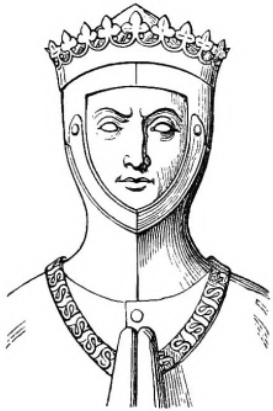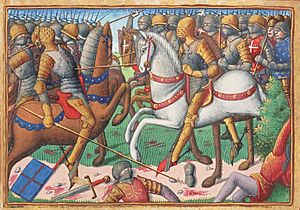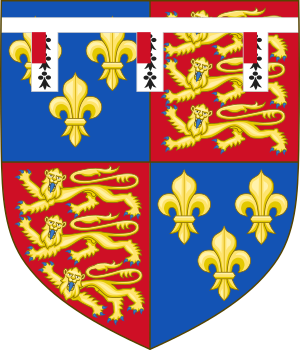Thomas of Lancaster, Duke of Clarence facts for kids
Quick facts for kids Thomas of Lancaster |
|
|---|---|
| Duke of Clarence | |

Drawing of his tomb effigy
|
|
| Born | Autumn 1387 Probably London |
| Died | 22 March 1421 (aged 33) Battle of Baugé, Anjou, France |
| Burial | Canterbury Cathedral, Kent |
| Spouse | Margaret Holland (m. 1411) |
| Issue | John of Clarence (illegitimate) |
| House | Lancaster |
| Father | Henry IV of England |
| Mother | Mary de Bohun |
Thomas of Lancaster, Duke of Clarence (born around autumn 1387 – died 22 March 1421) was an important English prince and soldier. He was the second son of Henry IV of England and the brother of King Henry V. If his brother had died without children, Thomas would have been the next in line to the throne. He helped and advised both his father and his brother.
When Thomas was only 14, his father made him the Lord Lieutenant of Ireland in 1401. He arrived in Dublin in November 1401 and stayed in Ireland for about eight years. In 1406, he was almost killed in a small fight near Dublin. Thomas was likely born in London, though some people think he was born at Kenilworth Castle.
Contents
Thomas's Family Life
In late 1411, Thomas married Margaret Holland. She was the daughter of Thomas Holland, 2nd Earl of Kent and had been married before to Thomas's uncle, John Beaufort, 1st Earl of Somerset. Thomas and Margaret did not have any children together. However, Thomas became a stepfather to Margaret's six children from her first marriage. These children were also his first cousins.
Thomas did have a son named Sir John Clarence. He was sometimes called "Bastard of Clarence" because he was born outside of marriage. John fought alongside his father in France.
Thomas's Public Service
In 1411, Thomas's father, King Henry IV, became ill. His older brother, Prince Henry, took charge of the royal council. But the prince and his father disagreed about going to war with France. Prince Henry wanted war and gathered supporters for his idea.
The king removed Prince Henry from the council because he went against his wishes. Thomas was then given his brother's place on the council. He supported his father's plan for peace. Even though he was still Lord Lieutenant of Ireland until 1413, he did not go back to Ireland after 1409. He tried his best to keep peace in Ireland, but it was hard because there was never enough money.
Thomas's Military Actions

Thomas fought in France during the wars led by his brother, King Henry V. He took part in the Siege of Caen and the Siege of Rouen. During the Siege of Rouen (from July 1418 to January 1419), he led the English forces surrounding the city.
After King Henry V made a deal called the Treaty of Troyes, he became the heir to the French throne. The king then went back to England with his new wife. But the French prince, called the Dauphin, did not accept this. He kept fighting with help from a Scottish army led by John Stewart, Earl of Buchan.
Following King Henry's orders, Thomas led 4,000 soldiers on raids through parts of France. They faced little resistance. By Good Friday, March 21, 1421, the English army set up camp near the town of Vieil-Baugé. A combined French and Scottish army of about 5,000 soldiers also arrived nearby to stop the English. This army was led by the Earl of Buchan and the Marshal of France. Many English archers had gone off to find food or treasure, so the English forces were spread out.
On Easter Saturday, some English soldiers found a Scottish fighter and brought him to Thomas. Thomas wanted to fight the enemy right away. However, the next day was Easter Sunday, a very holy day, and fighting would be wrong. Waiting two days was also not an option. Some stories say that both commanders agreed to a short break for Easter, but then they fought that same day.
Thomas might have thought the French and Scottish army was smaller than it was. He decided to attack quickly with his cavalry (soldiers on horseback) instead of using his archers. With only about 1,500 men and almost no archers, he charged into the enemy lines. The attack surprised the French and Scots at first. But soon, Thomas and his knights were surrounded. A Scottish knight knocked Thomas off his horse. Another Scottish soldier, Sir Alexander Buchanan, then killed him on the ground, probably with a heavy weapon called a mace.
Thomas's Burial
Thomas's son, John, brought his father's body from Baugé, France, to Canterbury Cathedral in England for burial. King Henry V had given this Sir John Clarence some land in Ireland. After Thomas's death, King Henry V had to return to France with a new army to fix the situation.
Titles and Awards
Important Titles Thomas Held
- Duke of Clarence and Earl of Aumale (from July 9, 1412, until his death on March 22, 1421). These titles ended when he died.
Honors Thomas Received
- Knight, Order of the Bath (from October 12, 1399, until his death)
- Knight, Order of the Garter (from 1400 until his death)
Key Jobs Thomas Held
- Lord High Steward of England (1399–1421) — This was the most important job in medieval England, and he was the last person to hold it permanently.
- Chief Governor of Ireland (1401–1413)
- Lord High Admiral (1405–1406)
- Lieutenant of Aquitaine (1412–1413)
- Lord High Steward of Chester (1415)
- Constable of the Army (1417)
- Lieutenant-General of the Army in France and Normandy (1417 and 1421)


